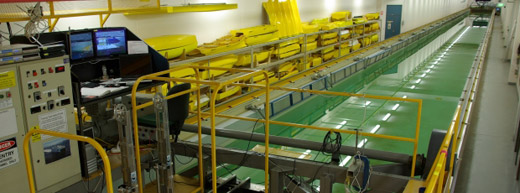
AMC's Towing Tank is the largest and only commercially operating facility of its type within Australasia.
The Towing Tank is a fundamental tool utilised by naval architects and other engineering professionals for conducting physical model experiments within a controlled environment. The most common tests performed in the facility are to measure the resistance and motions of surface ships and submarines in order to provide full-scale powering and motions predictions, which may be required to reduce fuel costs, reduce motions/seasickness incidence or limit environmental damage.
The Tank is used by students, research organisations and industry to conduct a wide variety of experiments, providing hands-on experience and opportunities for experimental modelling.First commissioned in the mid-1980s, AMC has built up considerable experience in test and analysis techniques, not only for straight forward towing tank tests on conventional craft, but also for specialist experimentation and unusual configurations.
A software controlled wave-maker can generate a wide variety of wave forms, including regular sinusoidal waves, many of the standard irregular wave spectra and user-defined wave sequences. Once a test is completed, wave dampening devices rapidly return the body of water to a calm state, removing the need for long wait times between experiments.
There is a range of fit-for purpose dynamometers for measuring towing force, sway forces and yaw moments, and thrust and torque at propeller hubs.
Motion measurements can be made using conventional displacement transducers or using a state-of-the-art portable Qualisys digital video motion capture system consisting of up to 8 cameras provides the ability to track all six degree-of-freedom motions for multiple floating models.
Manoeuvering forces can be measured using our horizontal planar motion mechanism (HPMM), or a static pitch mechanism.
We also have dedicated test rigs to quantify the performance of both horizontal-axis and vertical-axis turbines/propellers/rotors (tidal energy turbines etc).
Laser diagnostic tools, such as Particle Imaging Velocimetry (PIV), can be used to quantify water flow in/around objects (we custom-make our own neutrally buoyant fluorescing particles to suit the experiment). Flow observations can also be performed using more traditional paint-streak or tuft methods.
We have adapted stereo-videogrammetry techniques to quantify wave surfaces (using custom-made positively buoyant fluorescing particles/flakes).
Arrays of hydrophones can be deployed within the tank (or models) to measure hydrodynamic noise.
AMC has been an active member of the International Towing Tank Conference (ITTC) since 1987. ITTC assists in resolving technical problems of importance to all model test laboratories. These laboratories provide advice and information regarding full-scale performance to designers, builders, and operators of ships and marine installations based on physical and numerical modelling.
AMC have a number of highly professional and experienced model makers who are accustomed to the demanding requirements associated with the manufacture of experimental scale models.
At a Glance
| Length | 100 metres |
| Width | 3.55 metres |
| Depth | 0 to 1.6 metres (standard = 1.5m) |
| Model towing carriage speed | 0 to 5.0 metres/second |
| Typical model length | 1.0 to 2.5 metres |
For further details please contact A/Professor Gregor MacFarlane
